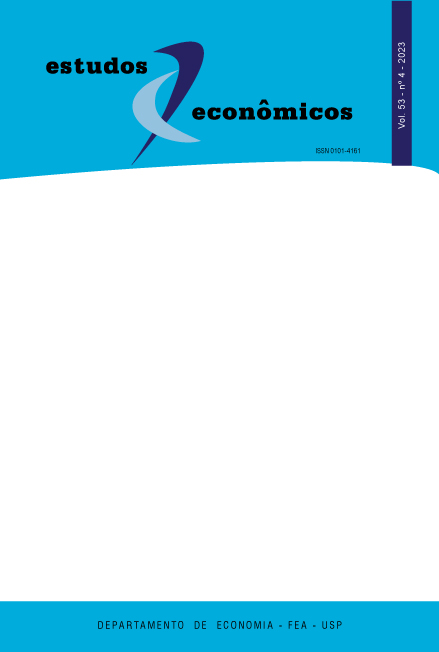A equivalência Ricardiana sob restrições de colateral
DOI:
https://doi.org/10.1590/1980-53575341jjjPalavras-chave:
Equivalênica Ricardiana, Restrições de colateral, Neutralidade da dívidaResumo
Este artigo investiga a Equivalência Ricardiana (ER) sob dívida colateralizada, inadimplência, custos de transação e mercados incompletos. A dívida pública é neutra e a RE é válida somente se o custo da transferência de garantias depender linearmente do imposto lump sum e for totalmente compensado. Credores e tomadores devem celebrar um acordo voluntário para compensar quaisquer custos de transferência em caso de descumprimento. Contudo, qualquer perturbação na relação afim assumida compromete a neutralidade da dívida. Não é o custo de transação em si que invalida a RE, mas sim a forma como este custo afeta o endividamento e a restrição orçamentária das famílias. O mecanismo subjacente é o canal de crédito da política fiscal. Sempre que o custo da transferência não é totalmente compensado, há uma sobra de saldo tributário líquido que afeta o conjunto orçamentário e as dotações reais. Isto é fundamentalmente diferente de uma economia com restrições de liquidez porque o canal de crédito da política fiscal é ativo e os custos de transação não compensados levam ao fracasso da ER.
Downloads
Referências
Abel, A.B. 1986. The Failure of Ricardian Equivalence under Progressive Wealth Taxation, Journal of Public Economics 30(1): 117-128.
Araújo, A., Pascoa, M. R and Torres-Martinez, J.P. 2004. Collateral Avoids Ponzi Schemes in Incomplete Markets. Econometrica: 70(4): 1613-1638.
Arellano, Cristina. 2008. Default Risk and Income Fluctuations in Emerging Economies.
American Economic Review 98(3): 690-712.
Barro, R.J. 1974. Are government bonds net wealth? Journal of Political Economy 82: 1095-117.
Barro, R. J. 1976. Perceived Wealth in Bonds and Social Security and the Ricardian Equiv- alence Theorem: Reply to Feldstein and Buchanan. Journal of Political Economy 84: 343-350.
Barro, R.J., 2023. r Minus g. Review of Economic Dynamics 48: 1-17.
Bassetto, M., Kocherlakota, N., 2004. On the irrelevance of government debt when taxes are distortionary. Journal of Monetary Economics 51, 299-304.
Brunnermeier, M. K., Eisenbach, T. M. and Sannikov, Y. (2012) Macroeconomics with financial frictions: A survey. In: Advances in Economics and Econometrics, Tenth World Congress of the Econometric Society, v. 2, pp. 4-94, Cambridge University Press.
Buchanan , J. M. 1976. Barro on the Ricardian Equivalence Theorem. Journal of Political Economy 84: 337-342.
Carmichael, J. 1982. On Barro’s Theorem of Debt Neutrality: The Irrelevance of Net Wealth.
American Economic Review 72: 202-213.
Divino, J. A. and Orrillo, J. 2017. Failure of the Ricardian Equivalence Theory in Economies with Incomplete
Markets. Brazilian Review of Econometrics 37(1): 19-30.
Divino, J. A. and Orrillo, J. 2022. Robust Effects of a Debt-Financed Tax Cut in an Economy with Incomplete
Markets. International Tax and Public Finance 29: 191-200.
Evans, G.W., Honkapohja, S. and Mitra, K. 2012. Does Ricardian Equivalence Hold When Expectations are not Rational? Journal of Money, Credit and Banking 44(7): 1259-1283.
Feldstein, M., 1974. Social Security, Induced Retirement, and Aggregate Capital Accumula- tion. Journal of Political Economy 82: 905-26.
Ganakoplos, J. and Zame, W. 2014. Collateral Equilibrium: I: A Basic Framework. Economic Theory 56(3): 443-492.
Guerrieri, L. and Iacoviello, M. (2017) Collateral Constraints and Macroeconomic Asymme- tries. Journal of Monetary Economics, 90: 28-49.
Gorton, G. and Ordonez, G. (2014) Collateral Crises. American Economic Review 104(2): 343-378.
Hayford, M. 1989. Liquidity Constraints and the Ricardian Equivalence Theorem: Note. Journal of Money, Credit and Banking 21: 380-387.
Kitlikoff, L. J, Razin, A. and Rosenthal, R.W. (1990) A Strategic Altruism Model in which Ricardian Equivalence does not hold. The Economic Journal 100: 1261-1268.
Kiyotaki, N. and Moore, J. (1997) Credit Cycles. Journal of Political Economy 105(2): 211- 248.
Mendoza, E. G. (2010) Sudden Stops, Financial Crises, and Leverage. American Economic Review 100: 1941-1966
Panadés, J. 2001. Tax evasion and Ricardian equivalence. European Journal of Political Economy 17: 799-815.
Pouzo, D. and Presno, I. 2022. Optimal Taxation with Endogenous Default under Incomplete Markets. American Economic Journal: Macroeconomics 14(3): 1-41.
Ricciuti, R. 2003. Assessing Ricardian Equivalence. Journal of Economic Surveys 17: 55-78. Seater, J., 1985. Does Government Debt matter? A review. Journal of Monetary Economics
: 121-131.
Seater, J., 1993. Ricardian Equivalence. Journal of Economic Literature 31: 142-190. Simsek, A. (2013) Belief Disagreements and Collateral Constraints. Econometrica 81(1):1-53.
Strawczynski, M., 1995. Income Uncertainty and Ricardian Equivalence. American Economic Review 85(4), 964-967.
Downloads
Publicado
Edição
Seção
Licença
Copyright (c) 2023 José Angelo Divino, Jolivê Santana Filho, Jaime Orrillo

Este trabalho está licenciado sob uma licença Creative Commons Attribution-NonCommercial 4.0 International License.
A submissão de artigo autoriza sua publicação e implica o compromisso de que o mesmo material não esteja sendo submetido a outro periódico.
A revista não paga direitos autorais aos autores dos artigos publicados.
Dados de financiamento
-
Coordenação de Aperfeiçoamento de Pessoal de Nível Superior
Números do Financiamento 760/2018 -
Conselho Nacional de Desenvolvimento Científico e Tecnológico
Números do Financiamento 302632-2019-0 e 307126/2016-1.





 Atualizado em 14/08/2025
Atualizado em 14/08/2025